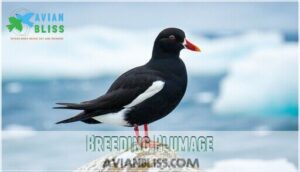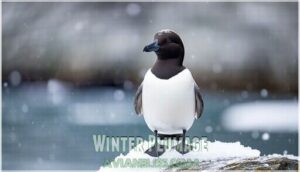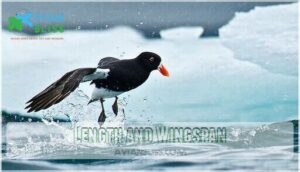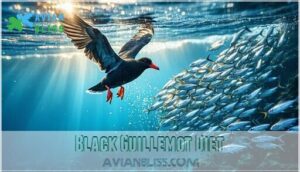This site is supported by our readers. We may earn a commission, at no cost to you, if you purchase through links.

This skilled underwater hunter transforms dramatically between seasons—sporting striking black plumage with bright white wing patches during breeding season, then switching to mottled gray-white winter colors.
They’re built for diving, plunging up to 75 feet deep to snatch small fish and crustaceans from the seafloor.
These hardy birds nest in rocky coastal crevices across the North Atlantic and Arctic Ocean, where they’ve mastered the art of surviving in some of Earth’s most challenging marine environments.
Their unique seasonal transformations reveal fascinating survival strategies, and are a key part of their ability to thrive in these areas, making them a skilled underwater hunter with a remarkable ability to adapt.
Table Of Contents
- Key Takeaways
- Black Guillemot Appearance
- Black Guillemot Size
- Black Guillemot Diet
- Black Guillemot Habitat
- Black Guillemot Breeding
- Frequently Asked Questions (FAQs)
- What is a black guillemot?
- Where do black guillemots live?
- What does a black guillemot look like?
- Where do black guillemots nest?
- Are black guillemots sexually different?
- Are black guillemots gregarious?
- What is the difference between a black Guillemot and a guillemot?
- What are some interesting facts about the black Guillemot?
- Are Guillemots related to puffins?
- How long do black guillemots typically live?
- Conclusion
Key Takeaways
- You’ll witness dramatic seasonal transformations – these Arctic seabirds switch from striking black plumage with white wing patches and red legs during breeding season to mottled gray-white winter colors for perfect camouflage
- They’re specialized underwater hunters – you can watch them dive up to 75 feet deep using their bright red feet as rudders to catch fish, crustaceans, and marine invertebrates from the seafloor
- You’ll find them in rocky coastal habitats – they nest in cliff crevices and boulder piles along North Atlantic and Arctic coastlines from Maine to Greenland, Iceland, and northern Russia
- They’re compact but hardy seabirds – measuring 30-32 cm with duck-sized builds, they’ve mastered surviving in Earth’s most challenging marine environments through their diving prowess and adaptability
Black Guillemot Appearance
You’ll instantly recognize a black guillemot by its striking seasonal transformation and distinctive features.
This duck-sized seabird displays bold black plumage with bright white wing patches and vibrant red legs during breeding season, then switches to mottled white and gray winter colors for perfect camouflage.
The combination of these features makes the black guillemot a unique and fascinating bird to observe.
Physical Characteristics
You’ll recognize this seabird species by its distinctive duck-sized frame and compact build.
The black guillemot displays remarkable plumage variation throughout the year, making bird identification both challenging and rewarding for observers.
Key physical traits include:
- Size: 30-32 cm length with 49-58 cm wingspan
- Bill shape: Thin, pointed for catching small fish
- Leg color: Bright red feet used in courtship displays
- Juvenile traits: Duller brown-black feather mix
- Molting process: Seasonal plumage changes for camouflage
Identification Features
When spotting black guillemots in their natural habitat, you’ll notice several key identification features that set this seabird species apart.
The bird’s distinctive red legs serve as nature’s bright warning flags, making Cepphus grylle instantly recognizable among Arctic waters.
Their thin, pointed bill shape differs markedly from thicker-billed relatives, while juvenile markings appear duller with mixed brown-black plumage variations.
Flight patterns reveal compact wings perfect for underwater pursuit.
Leg length and color, especially in waders, are diagnostic species tools.
Breeding Plumage
During breeding season, you’ll witness the black guillemot’s stunning transformation into its most striking appearance.
During breeding season, witness nature’s most dramatic avian makeover as sleek black plumage emerges.
The bird develops rich, velvety black plumage that covers most of its body, creating a dramatic contrast with its bright red legs.
This plumage purpose extends beyond mere aesthetics—it plays a vital role in attracting mates and establishing territory.
The breeding plumage’s display significance becomes evident through these key features:
- Intense black coloration that develops through the molting process
- Pristine white wing patches that flash brilliantly during courtship flights
- Vibrant red feet and legs that signal breeding readiness
Color intensity reaches its peak during incubation periods when breeding habits are most active.
The feather development process transforms winter birds into sleek, sophisticated adults ready for the demanding season of raising young.
This remarkable transformation signals the bird’s readiness to begin the critical cycle of laying eggs and nurturing the next generation.
Winter Plumage
When winter arrives, you’ll notice the black guillemot undergoes dramatic plumage change through seasonal molting.
The striking black body transforms into whitish feathers with mottled appearance, creating perfect camouflage adaptation against icy waters.
This Arctic bird’s winter plumage helps it blend seamlessly with snow-covered coastlines.
Birdwatching enthusiasts often find this seabird harder to spot during cold months due to its effective winter camouflage.
Black Guillemot Size
You’ll find black guillemots are compact seabirds, measuring 30-38 cm in length with wingspans reaching 52-58 cm.
These duck-sized birds weigh between 325-450 grams, making them distinctly smaller than their murre relatives but perfectly built for underwater hunting.
Length and Wingspan
You’ll find black guillemots measuring 30-32 centimeters in length with wingspans reaching 49-58 centimeters.
Their proportional differences create remarkable flight efficiency despite smaller wings compared to surface-feeding seabirds.
These average measurements showcase the bird’s compact build, perfectly suited for underwater hunting.
Bird anatomy reveals these characteristics optimize diving performance over soaring abilities, making black guillemot physiology uniquely adapted for their marine lifestyle.
Weight and Body Proportions
You’ll discover that adult black guillemots maintain a compact, streamlined build perfectly suited for underwater pursuits.
These hardy seabirds typically weigh between 325-450 grams, with body mass varying based on seasonal conditions and geographic location.
Here’s what defines their proportions:
- Weight Variation – Adults show considerable body mass differences between breeding and non-breeding seasons
- Juvenile Proportions – Young birds display lighter builds with less defined muscle development than adults
- Body Condition – Ideal weight fluctuates with food availability and reproductive demands throughout the year
Black guillemots share similar traits with their Pacific cousins, though Pigeon Guillemots inhabit different regions.
Comparison to Other Species
Among the Alcidae or auk family, you’ll spot key differences that set Black Guillemots apart from their relatives.
Unlike thick-billed and common murres, they’re markedly smaller with distinctive white wing patches.
Compared to puffins, they lack colorful beaks, while razorbills show different bill shapes.
Pigeon Guillemots share similar traits but inhabit Pacific waters, making geographic location your best identification clue.
Black Guillemot Diet
You’ll find that black guillemots are skilled underwater hunters, swimming beneath the surface to catch their prey in shallow coastal waters.
Their diet changes with the seasons and location, with northern populations eating more crustaceans while southern birds focus primarily on small fish.
Foraging Behavior
You’ll witness the black guillemot’s remarkable underwater swimming abilities as it pursues its black guillemot diet through specialized feeding behavior.
These seabirds demonstrate exceptional foraging efficiency through precise diving depths and strategic prey selection.
Key foraging behaviors that showcase their aquatic foraging mastery:
- Solo diving missions – They prefer hunting alone rather than group foraging, maximizing their underwater swimming success
- Shallow water specialization – Most dives occur within 30 feet, though they can reach 100 feet when needed
- Extended underwater endurance – Staying submerged up to two minutes while scanning the seabed
- Powerful foot propulsion – Using bright red feet as underwater paddles for enhanced maneuverability
Prey Species
While black guillemots show remarkable adaptability in their black guillemot diet, you’ll find they target specific prey categories.
Fish consumption dominates their feeding strategy, with Arctic cod and rock gunnel leading their preferences. Crustacean importance varies regionally—squat lobsters appear in 90% of North Norway samples.
Diet variation reflects local ecosystems, while seasonal prey shifts occur with breeding demands and ice conditions.
Their plumage helps with species recognition in the wild.
| Prey Category | Primary Species | Regional Frequency |
|---|---|---|
| Fish | Arctic cod, Rock gunnel | Up to 31% of diet |
| Crustaceans | Squat lobsters, Shrimps | Up to 90% in samples |
| Invertebrates | Mollusks, Polychaete worms | Opportunistic feeding |
Feeding Habits
You’ll often spot black guillemots foraging alone or in small groups, preferring this intimate approach over massive feeding flocks.
Their diving depths typically reach 30-40 meters, though they can push down to 100 feet when needed.
These skilled underwater hunters use their bright red feet as rudders while pursuing fish, crustaceans, mollusks, and marine invertebrates along the seabed.
Seasonal Variations
You’ll notice their diet shifts dramatically throughout the year. During summer breeding, black guillemots focus on fish like sculpins and cod, but winter brings diet shifts toward crustaceans and varied invertebrates.
These seasonal behavior changes reflect habitat use patterns – summer foraging occurs in shallow inshore waters, while winter plumage coincides with feeding along ice edges where different prey thrives.
The Isles of Shoals are the southernmost breeding location for these birds, showcasing seasonal behavior changes and diet shifts.
Black Guillemot Habitat
You’ll find black guillemots inhabiting the rocky coastlines of the North Atlantic, from Maine up through Greenland and across to northern Europe and Russia.
These specialized seabirds choose isolated cliff crevices, rocky islets, and boulder piles for nesting, always staying close to the shallow coastal waters where they hunt for fish and crustaceans.
Geographic Distribution
You’ll find black guillemots across the circumpolar Arctic Range, from Canada’s archipelago to northern Scandinavia’s rocky shores.
These hardy seabirds thrive in Coastal Habitats along Greenland, Iceland, and Russia’s coastlines, with Population Density peaks reaching 8 pairs per kilometer in Svalbard.
Their bird geographical range extends south to Maine and northern France, though Habitat Loss threatens these southern boundaries.
Unlike true migrants, they stick close to Wintering Grounds near breeding colonies year-round.
Preferred Nesting Sites
When searching for the perfect nest site, you’ll discover black guillemot facts reveal their strong site fidelity patterns.
These seabirds select rocky crevice locations within boulder pile formations along cliff faces, maintaining coastal proximity for easy access to foraging waters.
Colony size remains small, with pairs often choosing isolated nest sites using minimal nest materials like pebbles or debris.
They may also benefit from a specialized nesting box, which can be an important factor in their nesting success, and overall conservation efforts.
Foraging Locations
You’ll spot black guillemots hunting in shallow waters along rocky coastlines, where they target benthic zones rich with invertebrates and marine worms.
These skilled divers prefer coastal regions with depths rarely exceeding 100 feet, making open water near cliffs their prime feeding grounds.
- Shallow water zones – Primary foraging areas within 30 feet of surface
- Benthic fish habitats – Rocky bottoms where sculpins and blennies hide
- Diving depths – Typically 30-40 meters, occasionally reaching 100 feet maximum
Migration Patterns
Black guillemots don’t follow traditional bird migration patterns like clockwork. Instead, their Arctic migration depends heavily on sea ice conditions, which shift their seasonal range dramatically.
You’ll find these birds completing breeding dispersal by late August, then making coastal movements toward ice-rich areas.
| Migration Phase | Timing | Distance |
|---|---|---|
| Post-breeding dispersal | August-September | Up to 494 km from colonies |
| Arctic migration north | Late October | Reaching 72-75°N latitude |
| Winter habitats shift | November-December | Into Bering Sea region |
Their bird migration research reveals fascinating adaptations – these seabirds actually roost on sea ice for five hours daily, even in winter. This close relationship with ice means their bird distribution changes annually based on environmental conditions, making black guillemot range highly variable compared to other species, due to their unique dependence on Arctic migration patterns and breeding dispersal habits.
Black Guillemot Breeding
You’ll witness black guillemots’ fascinating breeding rituals from late spring through summer, when these Arctic seabirds transform their behavior completely.
They form strong pair bonds through synchronized swimming displays and bill-touching ceremonies before selecting rocky crevices for their nests, which is a crucial part of their breeding rituals.
Breeding Season
When does the black guillemot breeding season begin? Early breeding usually starts in late May to June across Arctic and sub-Arctic locations, with timing synchronized to food availability.
Here’s what characterizes their breeding season:
- Synchronized swimming displays between potential mates in cold coastal waters
- High-stepping courtship walks with necks stretched upward along rocky shores
- Bill-touching ceremonies that strengthen pair bonds before egg laying
- Small colony formations on isolated cliffs and rocky outcroppings
- Intense foraging activity as parents prepare for incubation period demands
First breeding typically occurs at four years of age, with pairs showing strong nest fidelity by returning to previous sites. The breeding season timing guarantees chick development occurs during peak food abundance in shallow coastal waters, ensuring the young have the best chance of survival with proper nutrition and care.
Nesting Behavior
You’ll find these seabirds choosing nest sites with the precision of a seasoned real estate agent, favoring rocky crevices, cliff cavities, and boulder piles close to water.
Their nest site selection prioritizes predator defense over comfort, with nesting materials consisting of simple pebble arrangements or bare rock scrapes.
Nesting density remains low, as pairs prefer isolated locations that maximize nesting success through natural protection. Notably, some may seek materials for the nest to enhance comfort.
Pair Bonding
Two creatures destined to share life’s journey, black guillemots form monogamous partnerships through intricate courtship rituals and bonding displays.
You’ll witness these seabird behavior patterns as pairs engage in synchronized swimming, head bobbing, and bill touching near their chosen nest site.
These lifelong partners demonstrate remarkable mate fidelity, with bird pair bonding strengthened through repeated mating rituals and consistent bird social behavior throughout breeding seasons, showcasing their lifelong commitment.
Chick Rearing
Both parents work around the clock during chick development, delivering up to 20 fish daily through careful chick provisioning.
Their shared parental roles guarantee steady bird feeding patterns, with morning visits most frequent.
To guarantee chick health, one might consider specialized brooding equipment.
This dedicated bird parenting approach, combined with strategic bird incubation beforehand, creates ideal conditions for robust chick development and future fledging success through consistent post-fledging care preparation.
Fledging and Independence
Young guillemots typically fledge 31-50 days after hatching, leaving their nests during nighttime hours for safety.
After fledging timeline completion, parents continue post-fledge care by teaching independence skills like diving and hunting techniques.
Juvenile survival depends heavily on this bird parenting phase, as adults guide their offspring through vital bird development stages.
The Cepphus columba, or pigeon guillemot, is a Pacific coast relative.
Eventually, dispersal patterns lead young birds away from breeding colonies, marking their shift to complete bird independence in the challenging Arctic marine environment.
Frequently Asked Questions (FAQs)
What is a black guillemot?
Imagine spotting a striking black-and-white seabird with crimson feet diving near Maine’s rocky coast.
You’re looking at a black guillemot, a duck-sized Arctic seabird that breeds in cliff crevices and dives underwater to catch fish and crustaceans.
Where do black guillemots live?
You’ll find black guillemots along rocky North Atlantic and Arctic coastlines, from Maine to Greenland, Iceland, Scandinavia, and northern Russia.
They nest in cliff crevices and forage in nearby shallow waters.
What does a black guillemot look like?
You’ll recognize this seabird by its duck-sized body featuring striking black plumage with distinct white wing patches and bright red legs.
During winter, the black transforms into mottled white and gray for camouflage purposes.
Where do black guillemots nest?
You’ll spot rocky crevices along rugged coastlines where these seabirds tuck their nests.
They choose boulder piles, cliff cavities, or spaces under driftwood—always close to water’s edge for easy access.
Are black guillemots sexually different?
Black guillemots show minimal sexual dimorphism.
You’ll notice males are slightly larger than females, but both sexes display identical black and white plumage patterns, red legs, and seasonal molting changes.
Making field identification challenging, especially with minimal sexual dimorphism and identical plumage patterns, is a key consideration.
Are black guillemots gregarious?
You’ll find they’re moderately social birds.
They’re more social during breeding season than winter.
Black guillemots nest in small colonies or isolated pairs, unlike highly gregarious seabirds that form massive flocks.
What is the difference between a black Guillemot and a guillemot?
You’ll discover dramatic differences between "guillemot" species.
Black guillemots are smaller seabirds with distinctive white wing patches and bright red legs, unlike common guillemots which are larger, brownish, and lack these striking features, including distinctive white wing patches and bright red legs.
What are some interesting facts about the black Guillemot?
You’ll find these seabirds fascinating because they’re unusual among auks.
They typically lay 2-3 eggs instead of just one, and they’re surprisingly small yet powerful divers, reaching depths of 20 meters underwater.
Are Guillemots related to puffins?
Yes, you’ll find that guillemots and puffins are closely related seabirds – they’re both members of the auk family (Alcidae).
These "wing-propelled" diving birds share similar underwater hunting abilities and coastal breeding habits, though they’ve evolved distinct appearances and behaviors, as members of the Alcidae.
How long do black guillemots typically live?
Time’s a tickin’, but you’ll find these seabirds live relatively short lives. Guillemots typically live around 11 years, though the oldest recorded reached at least 27 years.
Conclusion
Like their mythical Arctic cousins who transformed to survive harsh winters, the black guillemot stands as nature’s master of adaptation.
You’ve discovered how these remarkable seabirds seamlessly shift between striking breeding colors and camouflaged winter plumage while maintaining their diving prowess year-round.
Understanding the black guillemot’s seasonal changes, specialized hunting techniques, and rocky coastal nesting preferences reveals why they’ve thrived in Earth’s most challenging northern waters for millennia, showcasing their ability to thrive.













